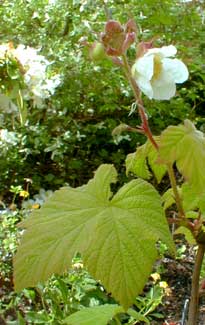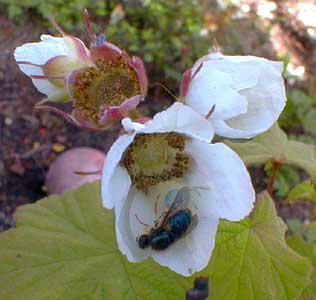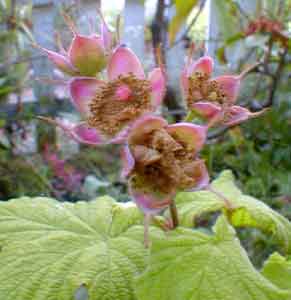
Western
Thimbleberry
"For he without his maid may go
To the heath with elder boys,
And pluck ripe berries where they grow:
Well may William then rejoice."
-Charles Lamb
(1775-1834)
(1775-1834)
Rubus parviflorus is a near relative of raspberries. It is a particularly welcome garden shrub because it has sweet tasty berries but no thorns & does not grow large & rampant. It forms a shrub of about six feet high & wide. It has four to eight inch green to yellow-green maple-like leaves that feel like felt, & which turn brightly golden before autumn leaf-fall.
Showy white flowers occur May through July. The first flower photo was snapped in late May, the second photo early in June. There's obviously a dead pollinating fly inside one of the flowers, but if you look closer, you'll see a tiny spider that killed this big fly, & the spider is the same color as the flower bloom. I've seen similar color-coordinated spiders inside blue flowers & inside red flowers.
I have been curious about these spiders since I was a child & first noticed them lurking in my great-grampa's cornrows of dahlias, a different colored spider for each bloom. These were always sideways-moving crab-spiders, which build no webs. Some people call them flower-spiders because of where they are usually spotted.
 But what I always wondered is, do they change colors to match the flower, or is the given spider always the same color & has to search for blooms they coordinate with? Well, that's what encyclopedias are for, & I can hardly believe I waited so long in life to actually look it up. Crab spiders are slow-moving & rely on their camouflage ability to ambush prey invisibly from within a bloom.
But what I always wondered is, do they change colors to match the flower, or is the given spider always the same color & has to search for blooms they coordinate with? Well, that's what encyclopedias are for, & I can hardly believe I waited so long in life to actually look it up. Crab spiders are slow-moving & rely on their camouflage ability to ambush prey invisibly from within a bloom.They can indeed change their color to match the flower they've discovered. It can take a few days to entirely change, so they will stick with a given flower or shrub for as long as it is in bloom. If removed to a flower of a different color, they are apt to leave & find a properly colored blossom rather than go hungry for the days it takes to change again. The most common crab spiders have a color range that is only from white to yellow, but of the hundreds of species that exist, there is a full range of color possibilities, with bright reds, oranges, & even blue particularly attractive to see.
But to return to the topic at hand, the excellent summer fruits of thimbleberries overlap the flowers. Both the flowers & fruits have a pleasing odor. The fruit can ripen during a single warm day, going from hard & pink to soft & the deepest ruby-red in a matter of hours, so it has to be picked quickly or it will fall from the branches. This is probably the only reason they're not as often gathered from the wild as are other superb berries; pickers would have to be very much on top of them watching for the veritable hour they're ripe. The third photo, from July, shows flower-like pink sepals after the fruit has fallen.
 Flowers & fruits are on two-year-old canes. When pruning in autumn, avoid the young green canes, & remove to the oldest canes. They are adaptable to a wide range of conditions, but the ideal is moist rich soil in dappled sunlight or partial shade.
Flowers & fruits are on two-year-old canes. When pruning in autumn, avoid the young green canes, & remove to the oldest canes. They are adaptable to a wide range of conditions, but the ideal is moist rich soil in dappled sunlight or partial shade.It is a native shrub quite common here in the Pacific Northwest. It is found growing in parks, woodlands, & along roadsides where there is plenty of moisture, even if only run-off ditches. Their range in North America is extensive from southern Alaska through British Columbia, Washington, Oregon, California, northern Mexico & New Mexico, & eastward through Canada as far as the Great Lakes.
Tribal peoples traditionally harvested not only the berries, but also dried the leaves for use throughout the year in teas of mixed berry leaves. Because the ripe berries are so briefly on the branches, & because they were adored by birds & other animals, first peoples would sometimes pick them while still pink & unripe, & let them finish ripening in a bag woven of cedar bark. Young thimbleberry shoots were harvested as asparagus-like vegetables, needing to be peeled before eaten raw, or added to stews.
It is today used in amateur winemaking, & is a choice berry for homemade jellies, though some canners regard them as too seedy for jams. Some folks use thimbleberry leaf tea as a tonic, though to date no science supports any of the medicinal properties occasionally assumed for the leaves.
Though usually restrained in the garden, it may sucker to excess if ignored, spreading over an area from its rhizomes. In the wild, they tend to die out of old forests for a couple reasons that can be avoided in the garden. First, they prefer recently disturbed locations such as along new roads or where trees have been harvested or especially where forest fires have occurred. They are among the first plants to appear at the start of a disturbed area's recovery. Later when larger shrubs are getting re-established, thimbleberries are not aggressive enough to compete.
Second, even in understory locations where larger shrubs don't displace them, thimbleberries are heavy nitrogen users & decline when soil nutrients decline. In the garden, then, it needs not to be crowded by too many large shrubs, & it needs at least an annual fertilizing as for other deciduous fruiting trees & shrubs.